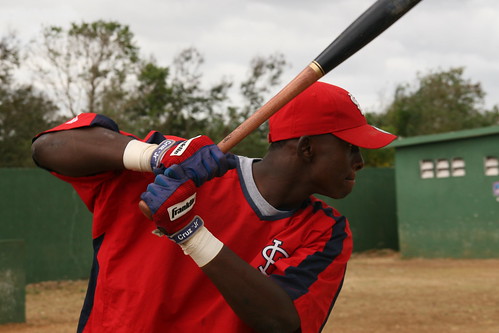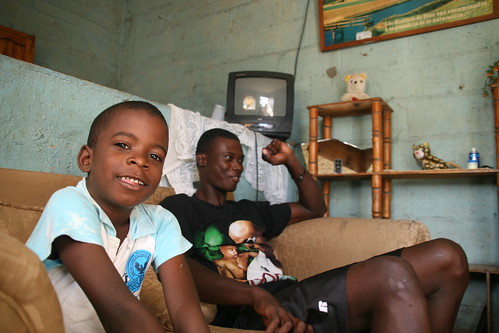I made Jon Paley's acquaintance over a year ago as he and his colleagues work on a documentary about amateur baseball talent in the Dominican Republic came to my attention. I found their work very impressive in terms of film aesthetics, but also in the subject matter. Although most baseball fans are aware of the major flow of talent coming in from the Dominican Republic, few actually know anything much about it. The whole industry is quite interesting and works in a way that is very different from what domestic talent experiences. Jon was kind to great us an interview with him, which is printed in its entirety after the jump.
Below is an excerpt from a rough cut of his film. Be sure to visit their site Pelotero: the Movie to see more videos, pictures, and lots of information. One very exciting part of their work is that they were able to cover Miguel Jean as he went through the process of undergoing age related issues and finally earning his first pro contract with the Minnesota Twins.
Click on the following link to read the full interview with Jon Paley.
Camden Depot: Could you introduce the film and describe how you have been able to acquire access to these prospects and any difficulties you have faced?
Jon Paley: Our film, titled Pelotero, tells the story of four Dominican ballplayers, ages 16-19, working day in and day out trying to get signed by an MLB team. We provide a complete look into their lives; at home, with their trainers, at MLB academies where they hold tryouts...everything. We bridge these intertwined stories with a look into how the system works to help give context to the characters and the odds that they face.
 We spent 8 months down there which is a big reason why we were granted such amazing access. Scores of reporters and journalists make brief visits to the DR following scandals or hyped players but they never set up shop and try to learn what the motivations and consequences are behind the scenes. By showing up every day to the same fields and hanging around during practice, we gained the trust of trainers, and scouts.
We spent 8 months down there which is a big reason why we were granted such amazing access. Scores of reporters and journalists make brief visits to the DR following scandals or hyped players but they never set up shop and try to learn what the motivations and consequences are behind the scenes. By showing up every day to the same fields and hanging around during practice, we gained the trust of trainers, and scouts. Getting access to MLB teams academies could be a little trickier. Some teams were very receptive and gave us full access. Others were a little wary of having a camera crew hanging around.
We produced Pelotero independently under our company Guagua Productions, by myself, Ross Finkel, Trevor Martin and Casey Beck. We are all young, hungry, aspiring filmmakers who were looking for a story to tell and found that and more in the world of Dominican Baseball.
CD: How one becomes a buscon and the process of identifying and training players. What relationship does a buscon have with the estbalished academies, and what role does a buscon play in promoting his trainees?
JP: Quick clarification—the term ‘buscon’ has become something of a derogatory term implying corruption, lying and cheating. The majority of trainers in the Dominican Republic prefer the term 'entrenador' or trainer.
There is no barrier to entry to become a trainer in the Dominican Republic. The are thousands of trainers across the country ranging in seriousness and experience. Some begin grooming their sons or nephews in the streets and will hand that player off when they begin to show some promise, while others have neatly manicured complexes with state of the art facilities. Many of the thriving programs are run by ex-players who know how to teach kids, and who surround themselves with talented specialized coaches. Trainers will begin scouting players as young as 12, and enrolling them in their program. Trainers find players in two main ways. First, they maintain a close network with other coaches of little leagues for younger ages who will alert them to any special talents. Secondly, once a trainer is established within a community family members will bring their eligible players to try out. Spots in the better programs are highly desired and often competitive.
Every MLB team has a network of area scouts which travel the country scouting players. These scouts visit several programs a day looking for the best talent. If they like a player they will have the trainer bring that player to the academy for a tryout. The more experienced trainers have signed many players in the past and have close relationships with area scouts and academy directors. The better these relationships the easier time they will have getting attention for their players.
CD: What is the daily routine for an academy ball player as opposed to the daily routine for a prospect with a buscon? Are there differences in resources, amenities, equipment, etc.?
 JP: The MLB academies are a huge step up for almost all players in the DR. They are equipped with perfectly maintained fields, experienced coaches, dormitories, nutritional food, and all the amenities one needs to stay focused on playing baseball. Very few independent trainers' programs can match this.
JP: The MLB academies are a huge step up for almost all players in the DR. They are equipped with perfectly maintained fields, experienced coaches, dormitories, nutritional food, and all the amenities one needs to stay focused on playing baseball. Very few independent trainers' programs can match this. In the majority of programs, kids live at home with their families who may struggle to put food on the table. They will come to their field in the morning and do drills for 4 or 5 hours that focus on fundamentals: hitting, fielding, running, etc. In the afternoon they will continue with more drills or occasionally play an organized game against another program. Some of the better trainers' provide dormitories for the kids as well as food and equipment. Scouts are looking more and more for players with game experience and there is a growing trend for better trainers to emphasize playing games.
Within the academy the schedule is not too different. Players wake up early, practice for several hours, come in for lunch and to lift weights. In the afternoon they will continue with drills or a simulated game. In the summer there is a short season that pits academy teams against each other.
The main differences are the level of professionalism in the academies and the focus. In general the academies teach kids to play baseball while the trainers programs teach kids to excel at tryout skills (batting practice, 60 yard dash, fielding grounders).
CD: Do certain organizations have a reputation for being more friendly/accomodating/inviting for young Latin American players? Are there certain organizations that are viewed more positively than others? Negatively?
JP: Different teams in the DR have different ways of doing things. Some have nicer academies with better coaches, and others are seriously underfunded. One of the biggest disparities between academies is their focus and helping their players assimilate when they get to the States. Every academy is required to have an english program that teaches kids the language, and about American culture. These classes help players acclimatize when they get to the states and help them perform better on the field. Some teams do a far better job of this than others. The Rays for example have a complex system set up where they continue to have classes for Latin American players all the way through the Minors. In some other academies, the teachers barely speak english.
CD: Are families compensated in any way as a result of the academy/buscon/player relationship (monetary, employment opportunities, etc.)?
 JP: When a player signs a contract with a team, the trainer will usually take between 30-35%. While this seems extraordinarily high Dominican trainers have far greater responsibilities than anything a coach in the States has. They often pay to house and feed the player for up to 5 years. They pay for the fields to practice on and the equipment to play with. They have a staff of specialized coaches. The expenses are indeed great, and for every player that signs the trainer is fronting the cost for 20 that don't. If the trainer brings in an American agent, a phenomenon becoming more and more common, the agent may take another 5-10%.
JP: When a player signs a contract with a team, the trainer will usually take between 30-35%. While this seems extraordinarily high Dominican trainers have far greater responsibilities than anything a coach in the States has. They often pay to house and feed the player for up to 5 years. They pay for the fields to practice on and the equipment to play with. They have a staff of specialized coaches. The expenses are indeed great, and for every player that signs the trainer is fronting the cost for 20 that don't. If the trainer brings in an American agent, a phenomenon becoming more and more common, the agent may take another 5-10%. The remaining money goes to the the players family. The first thing nearly every player does is buy his mother a house. Its both a gift of gratitude, and a right of passage. For many players this may be their only payoff, so saving the money is crucial. Many trainers and teams provide financial advisers who will help their players families manage the money once they sign.
CD: What are your future plans for this film and beyond?
JP: We are still putting the finishing touches on Pelotero. We are currently fundraising to finish a re-edit of the movie. We will then being the lengthy process of submitting to film festivals and seeking distribution.
We also have plans to continue following several of the players form Pelotero. Miguel Angel Sano (now Miguel Jean) signed with the Minnesotta Twins for $3.15 Million, the second highest bonus ever paid to a Dominican prospect. We have been given access by the Twins to the academy and spring training facilities and will begin following Miguel's story again very soon. We hope to be able to follow him and our other characters all they way to the Majors.
If this is something that anyone out there is interested in seeing, please help make it happen and make a tax deductible donation to the project through our website: Peloterothemovie.com.
CD: I would like to thank Jon Paley for spending the time answering a few of our questions. This is a great project and I greatly anticipate watching this documentary. Be sure to check out the Pelotero site. There are more videos, pictures (those included in this post are from their site), and loads of information to digest. Very exciting.

No comments:
Post a Comment